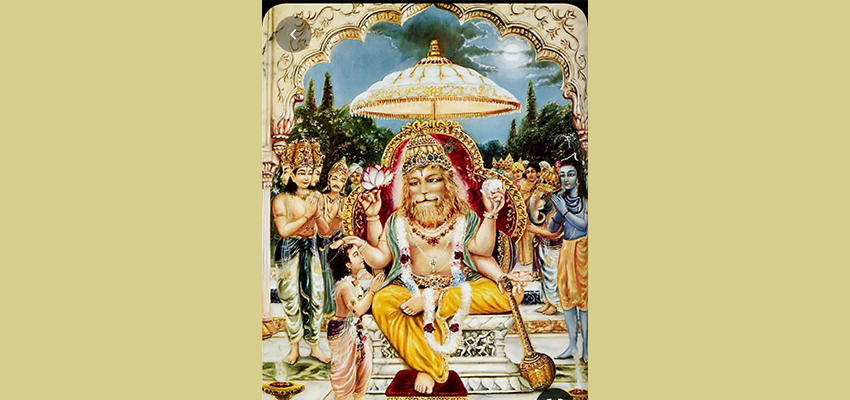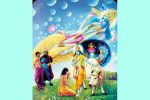NAME 21
Nārasiṁhavapuḥ नारसिंहवपुः
Nārasiṁha avatar of Viṣṇu is considered as one of His important incarnations. Nara or nāra means man, siṁha means lion and Vapu means body.
A brief note on His Nārasiṁha avatar: His fourteenth Avatar is Nārasiṁha avatar, whose form is widely worshipped. In Varāha avatar, Viṣṇu killed the demon Hiranyākśā. His brother Hiraṇyakaśipu deeply grieved by the death of his brother vowed to destroy Viṣṇu. He did tapas and got a boon from Brahmā that he would not be killed by any gods, human and beasts. After having obtained this boon, he conquered Indra and reached Vaikuṇṭha. Viṣṇu made Himself into a subtle form and entered the heart of Hiraṇyakaśipu. After failing to find Nārāyaṇa, Hiraṇyakaśipu was under the impression that fearing him, Viṣṇu had run away. The demon returned to his kingdom. Prahlāda was born to him and became a great devotee of Viṣṇu. Hiraṇyakaśipu tried all means to prevent Prahlāda from being a devotee of Viṣṇu but he miserably failed.
He then decided to eliminate Prahlāda, but again Hiranyakasipu failed. Deeply disconcerted with Prahlāda’sbehaviour, one day Hiraṇyakaśipu asked Prahlāda ‘who supports him’? Prahlāda replied by saying that Viṣṇu is the supporter of everything including Hiraṇyakaśipu. Challenging his son, Hiraṇyakaśipu struck a huge pillar with his mighty sword. There was a noise much louder than a thunder. By ripping open the pillar there appeared a form that was neither a god nor a human nor a beast. His body looked that of a human and his face and hands resembled a lion. This was the form of Nārasiṁha. Lord Nārasiṁha put Hiraṇyakaśipu on his lap tore open his chest by roaring like a lion. His roarings rattled all the worlds. Everyone was scared to go anywhere near Nārasiṁha. But, Prahlāda prostrated before Nārasiṁha and by whose love, Lord Nārasiṁha cooled down and vanished. (Nārāyaṇīya: Canto 25)
This incarnation is said to be of shortest duration. There are two Upaniṣad-s for this incarnation. They are NṛsiṃhaPūrvathāpiniUpaniṣad and NṛsiṃhaUtharathāpiniUpaniṣad. Nṛsiṃha mantra beginning with ‘ugravīrammahāviśnuṃ’ is known as mantra rājaṁ, which means the king of all mantras or the superior mantra. There are 32 akṣara-s in this mantra and each of these letters represents one god. There are specific ways of reciting this mantra rājaṁ in combination with certain other mantras which eradicates all miseries (NṛsiṃhathapaniUpaniṣad-s).
Following Is The Mantra RājaMantram:
ॐugravīraṁmahāviṣṇuṁjvlaṁtaṁsarvatomukhaṁ|
nṛsiṁhaṁbhīṣaṇaṁbhadraṁmṛttumṛttuṁnamāmyaham ||
ॐugravīraṁmahāviṣṇuṁjvlaṁtaṁ
sarvatomukhaṁ|
nṛsiṁhaṁbhīṣaṇaṁbhadraṁmṛttumṛt
tuṁnamāmyaham ||
ॐउग्रवीरंमहाविष्णुंज्व्लंतंसर्वतोमुखं।
नृसिंहंभीषणंभद्रंमृत्तुमृत्तुंनमाम्यहम्॥
Note: Nārasiṁhavapuḥ means “the one whose form (vapus) is that of Narasiṁha (Nārasiṁha)”. The name of the “avatāra” is then: “Narasiṁha” (Man-lion), and not “Nārasiṁha” (lit. of or related to Narasiṁha; i.e. the “a” vowel is made long in order to show relation to “Narasiṁha”, that is, “that of Narasiṁha”).
Nṛsiṁha = Narasiṁha (they mean the same thing).
२१. ||ॐ नारसिंहवपुष: नमः||
21. Om Nārasiṁhavapushey Namah
Naarasimha-vapuh -One whose form (“vapuh”) is half human (“nara”) and half lion (“simha”).This is the famous fourth incarnation of Lord Vishnu which He took in order to destroy the atheistic tyrant Hiranyakasipu and bless his devotee, Prahlaada.
INTERPRETATION GUIDED BY SANT VANI (WORDS OF SAINTS)
Nārasiṁhavapuḥ
The one with the body of a man-lion.
Nārasimha-vapu is one who has a body, wherein some parts are those of a simha, a lion and some parts are those of a nara, a human being. This is a saguṇa and sākāra form. This is the name of the Lord based on His avatāra. In an avatāra, the Lord assumes a particular form, to serve a particular purpose.
Lord Viṣhṇu in His role as the sthiti-kartā, as the one who sustains dharma, has to assume particular forms as an answer to the prayers of the people and this is called avatārā. Avatārā is līlā. One of His avatāras is Nārasimha-avatāra. Prahlāda is the son of Hiraṇyakśipu an asura, who won all the worlds and took himself to be the Lord. In his kingdom, everybody had to repeat only his name and nobody was to repeat the name of Lord Nārāyaṇa. His son Prahlāda, along with few other people went on repeating the name of Hari and singing the glories of the Lord. The father came to know about this, chastised him and forbade him to utter the name of the Lord. Prahlāda refused to listen to him and went on repeating the name of the Lord.
The father tried many ways to punish and also to kill his son, but he could not do so. One day, the father confronted his son, asking him, ‘where is the Lord Hari that you sing of?’ Prahlāda replied that He is all-pervasive, He is everywhere. He is even in the pillar.
Hiraṇyakaśipu had a special boon granted to him. It was, that he should die neither inside nor outside the house, neither during the day nor in the night, neither on the earth nor in space, neither at the hands of a human being nor an animal, neither by a wet nor a dry weapon. These were all his conditions and when the boon was granted to him, he thought he was invincible.
Now, Hiraṇyakaśipu asked his son, ‘Is your Lord Hari in this pillar?’ and thus asking, he kicked the pillar. The pillar burst open and the Lord came out in the form which was neither that of an animal nor that of a human being. He had the head of a lion and the body of a human being.
The time was neither day nor night, but twilight, just before night sets in. He sat on the threshold of the door, which was neither inside nor outside, and placed Hiraṇyakaśipu on his lap because he should not die in space or on the ground. He should not use any weapons, and therefore He used His nails to kill him. Again the finger-nails cannot be said as wet or dry. This is an avatāra.
This story just tells us that the Lord blesses His devotees. The Lord is presented in this story as Nārasimha. So, it has the features of both the lion and the human being in this form, this form as Nārasimhavapu.
A jīva is an individual, born due to his own karma, with a particular body. When that karma is exhausted, he naturally dies. Rather, he quits this body to take another body which is in keeping with another set of karma. The cycle of repeated births and deaths is samsara and the one who is subject to samsāra, is a samsārī. To get out of this samsāra, knowledge of Self realisation is necessary. By understanding the names of the Lord, and knowing that the Lord and the individual jīva are essentially one and the same, one becomes free from samsāra. The mere repetition of the names
of the Lord is only a ritual and while it will give some puṇya as the karma-phala, it may not be enough to get one out of the cycle of birth and death.
Even though essentially, Īśvara is not subject to birth, and is also all-pervasive manifesting as the entire world, how is it that He is born with a single body? Further, Īśvara is akartā, a non-doer, He has no karma and therefore can have no karma-phala of His own. If so, how then is birth possible without karma?
Here, Prahlāda was praying to the Lord and in order to save him, the Lord took a form as Narasimha. It is in answer to the prayers of all the devotees, that the Lord takes birth. When the prayers of the devotees reach a critical point and when it is time for their karma-phala to fructify, then the Lord comes into being.
The Lord is not born out of His own karma. As a result of the punya created by the prayers of all the devotees, and keeping the puṇya as the material cause, the Lord takes a particular form which is suitable to the situation and which will serve the purpose. While a jīva is born subject to māyā, the Lord is, as though born, keeping māyā under His control. This is His divya-janma.
Is it only the devotees or any ārtajīvas including Indrādi devatas? Also, is this puṇya of only devotees or maybe puṇya of hiraṇyakaśyapu, rāvanādivirodha bhaktas (those who constantly think of viṣhṇu due to dveṣha or fear)? Essentially, I mean to ask that logically, it should be sum total of puṇyas of all the jīvas in jagat at the time of avatāra as per their prārabdha.
Otherwise, wouldn’t lord be dependent on puṇya of jīvas to do avatāralīlā which will compromise the omnipotence of Bhagavān? Bhagavān can’t be dependent on jīva’s karma for avatāralīlā. Also, what constitutes a prayer for Bhagavān to take avatāra? ārtanāstijīvas might also be involving lord indirectly.
Ramāvatāra had curse from nārada, prayers from brahma as the foundation, but the curse was
also arranged by bhagāvān through nārada’sahaṁkara alone. So, bhagavānṢriHari was always akartā.
Some more clarification on Bhagavān’s divyajanma
– Referring to Bhagvat Gita 4.7-9
Avatāra happens for three fold purposes.
1. For protection of those who are committed to life of dharma, for protection of dharmī is equal to protection of dharma.
2. To destroy those who follow adharma. Destruction here means, converting, chastising and disciplining adhārmic people, thereby protecting dharma.
3. The third reason, and the real reason for avatāra is reestablishment of dharma.
The collective prayer of everyone including devas, becomes the material cause, upādānakāraṇa, for Īśvara’s physical body. Given the above, the idea of dependence on jīva’s karmas does not arise. By the power of māyā
Īśvara has a birth, divyajanma. The whole creation is Īśvara’s form, but when he assumes a particular form for a particular purpose, we call that form an avatāra. The concept of avatāra is not mentioned in the Vedas, though devas are referred to. Rāmāyaṇa and Mahābhārata are itihāsas, meaning ‘this is how it was’. There are historical elements in them, but they are also poetry, and have the poetic license for creating the rasas, the aesthetic values, and all kinds of situations at will. Though Kṛiṣhṇa’s birth, body and actions are divyam, divine, it is to be understood as mithyā. If divyam is understood as something extraordinary, then we can get into difficulties about what liberation is. Saints have clarified that “tattvataḥvetti”, means knowing the reality of that divyajanma. Reality means sat, and there is only one sat, and therefore, knowing sat can only mean knowing aikyam between jīva and Īśvara. This is a very important point to note. Else, we can become the jñāni-bhakta not Kṛiṣhṇa bhakta.



